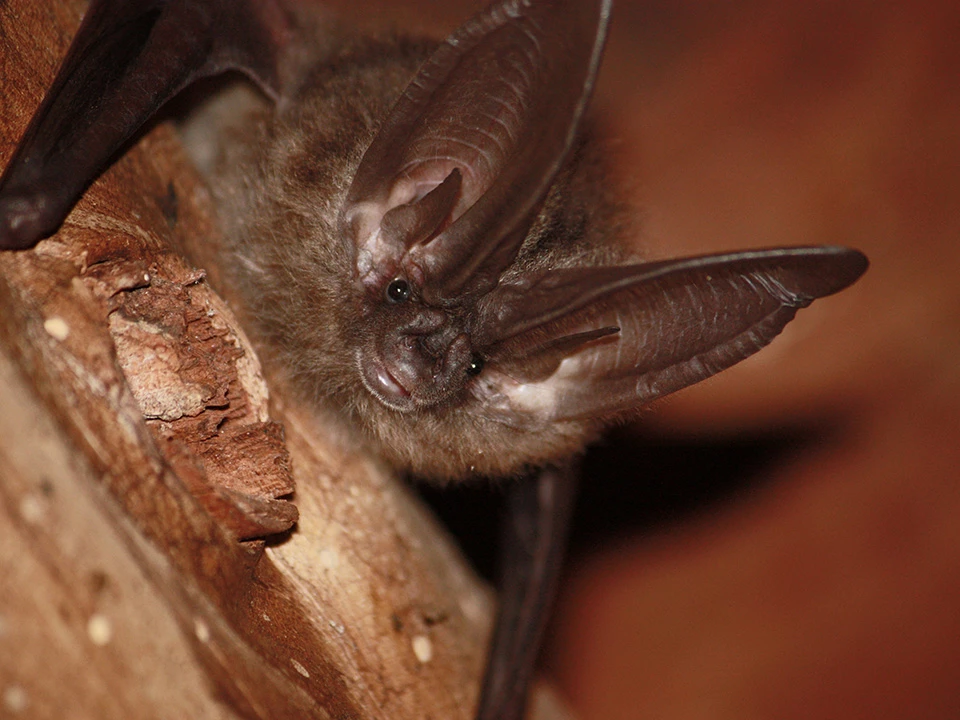Last updated: July 16, 2019
Article
Bat Inventory of Pinnacles National Park

ODFW / Don Albright
The Question
Which bat species are present at Pinnacles National Park? Are any sensitive species present?
Bats are economically and ecologically important animals, providing ecosystem services such as pollination and predation of insects. Most bat species are difficult to study in the wild because of their nocturnal foraging and cryptic, inaccessible roost sites. In general, bat populations are believed to be declining. The declines are likely due to direct and indirect human impacts, primarily through destruction of foraging and roosting sites. Most species have very low reproductive rates, producing about one offspring per year. Many species are also constrained by a limited number of specific roosting sites, despite large numbers of individuals in a population. These factors make recovery a slow process.
Forty-five species of bats are found in the United States. The central coast of California is known to support 17 species from two families (Vespertilionidae and Molossidae), nine of which have special status. All of these species are insectivorous, meaning they rely on insects as a primary food source.
Since Pinnacles National Park provides important and unique habitat for bats, baseline information on populations is critical to management needs. The talus caves of Pinnacles represent one such unique habitat. They were formed when steep, narrow canyons filled with rocks and boulders from the cliffs above and were supported in place by rocks and sand. These features are seen within the park at the Bear Gulch caves and the Balconies Caves.

Titley Electronics, Australia
The Project
Use multiple surveys for bat inventory at Pinnacles.
To characterize the diversity of bat species at Pinnacles National Park, researchers used multiple survey techniques, including acoustic sampling, mist-nets, and roost sampling from August 2004 through July 2005. Each method had inherent biases and different detection likelihood for each bat species.
Acoustic sampling involved the use of an AnaBat II Detector System to detect the ultrasonic echolocation calls and convert the signals into graphs on a computer. The graph of each call is unique and can often be used to determine the species based on the frequency, call shape, call duration, and time intervals. Acoustic sampling was conducted at eight sites within Pinnacles and operated between 7:30pm and 6:30am. This method detected 11 of the 17 bat species expected to be in the area.
Mist-nets similar to those used to capture birds were set over water, trails, and other known flyways. After capture in the mist-net, the bats were handled to collect data on the reproductive condition, sex, age, and body measurements. Bats were immediately released on-site once the data were collected.
Roost sampling was also used to inventory bats. Multiple sits, including the Bear Gulch Cave, were surveyed to determine their use as roost sites by bats.
Results
A total of 13 of species were documented at Pinnacles during the 2004-2005 surveys. Seven species had special status at the time of the survey.
An additional three species were likely to occur but were not positively identified during the inventory. Species were detected throughout the year, with reproductive populations present during the summer months. Species were observed foraging in riparian habitats and roosting in cave features.
| Scientific Name | Common Name | Special Status | Method of Detection |
|---|---|---|---|
| Myotis lucifugus | Little brown myotis | ---------- | *** |
| Myotis yumanensis | Yuma myotis | ---------- | Ac, Mn, V |
| Myotis evotis | Western long-eared myotis | FS, BLM | Ac |
| Myotis thysanodes | Fringed myotis | FS, BLM, WBWG | Ac, Mn |
| Myotis volans | Long-legged myotis | ---------- | *** |
| Myotis californicus | California myotis | ---------- | Ac, Mn, V |
| Myotis ciliolabrum | Western small-footed myotis | FS, BLM | Mn |
| Lasionycteris noctivagans | Silver-haired bat | ---------- | *** |
| Pipistrellus hesperus | Western pipistrelle | ---------- | Ac, Mn, V |
| Eptesicus fuscus | Big brown bat | ---------- | Ac, Mn, V |
| Lasiurus blossevillii | Western red bat | FS, WBWG | Ac, Mn |
| Lasiurus cinereus | Hoary bat | ---------- | Ac, Mn |
| Corynorhinus townsendii | Townsend's big-eared bat | FSC, CDFG, FS, BLM, WBWG | Ac, Mn, V |
| Antrozous pallidus | Pallid bat | CDFG, FS, CLM, WBWG | Ac, Mn, V |
| Tadarida brasiliensis | Mexican free-tailed bat | ---------- | Mn, V |
| Eumops perotus | Western mastiff bat | FSC, CDFG, BLM, WBWG |
Ac, V |
Special Status Codes: FSC =Federal Special Concern species; CDFG = California Department of Fish and Game's California Special Concern species; FS = Forest Service Sensitive species; BLM = Bureau of Land Management Sensitive species; and WBWG = Western Bat Working Group High Priority species. Method of detection codes: Ac =Acoustic detection; Mn = Mist net capture; V =Visual detection; and *** = not detected but presence possible.
Additional Resources
Contact Information
Links
San Francisco Bay Area Inventory & Monitoring Network
Pacific Coast Science & Learning Center
USGS Western Ecological Research Center
San Francisco Bay Area Network Species Lists - Certified Species lists including residency, abundance, and native/non-native status.
Summary by the Pacific Coast Science and Learning Center, May 2006.
Download PDF from the NPS Data Store
